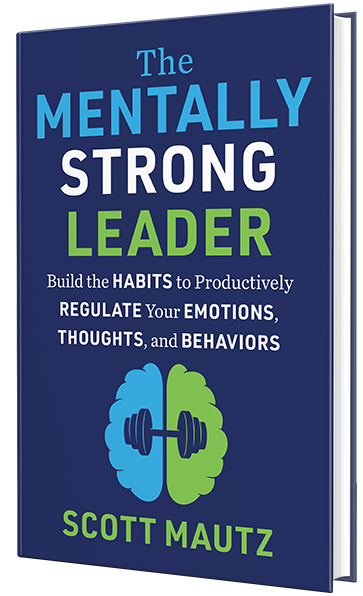
INSIGHTS (on leadership/self-leadership)
Practice is practice, you either do it to get better, or you don’t, right?
Wrong.
As I share in my recent book, The Mentally Strong Leader, you actually improve (and grow more confident) when you engage in deliberate practice, a special kind of practice that differs from your run-of-the-mill, mindless replication. Specifically, it’s purposeful repetition, focused on incremental improvement, that builds mental muscle memory. It breeds confidence because you know you’re improving (you can see/feel it), and because when it’s time to actually perform what you’re practicing, you don’t have to think about it so much, you know your mental muscle memory will kick in.
Here are the three steps to engage in deliberate practice (what I call, The Deliberate Drill).

I’ll illustrate by walking you through how I practice for one of my keynotes.
STEP 1 – Create a “scaled” routine for reps. You build mental muscle memory through repetition, so it’s important to schedule occasions where you can get your reps in, and stick to it. It’s also important to break down the process you’re practicing into smaller parts, and decide when you’ll focus on the smaller part, or the whole (i.e. the “scale” of each practice session).
For example, I start practicing my keynote four days in advance of the event. On that day, I ease into rehearsal by practicing key parts of the talk (like the opening and closing). Three days before, I run through the entire keynote once, and also practice key transition points. Two days before, I go through the entire keynote, twice. One day before, I run through it once, then on the morning of the actual event, I run through an outline of the talk, and drill down only on parts I want extra practice on. After this flow of scheduled, varied-in-scale reps, when it’s “go time,” the keynote flows from my consciousness without mental strain, freeing me up to focus on nuances in my performance (like dramatic pauses, movements on stage, etc.).
STEP 2 – Catch and cure. This step occurs in the midst of your practice, when you catch your mistakes and try new approaches/strategies to fix them for incremental improvement. This is as opposed to mindless repetition where you repeatedly rehearse while ignoring your mistakes. If I make an error while practicing my keynote, I either stop and fix it right in the moment, and then continue, or I make a mental note of it to go back to and address when I’m done running through the entire thing.
STEP 3 – Incorporate improvements. Take the incremental improvements you’ve made on each individual part you’ve been practicing, and build them into your overall process. The morning of my keynote event, as I’m running through an outline of the entire talk and practicing just key parts, I’m also making sure I’m integrating all the adjustments I’ve been making the prior four days.
IMPERFECTIONS (a mistake many make)
I was reminded recently of a profound exchange in philosopher Ayn Rand’s book, The Fountainhead, that serves as a powerful approach to not letting toxic forces have undue sway in your life. In the novel, two polar opposite characters, after repeatedly hearing of each other, finally meet, and a profound exchange ensues. The hero of the story, Howard Roarke, is a man whose work is driven by a sense of meaning and fulfillment. The antagonist, Ellsworth Toohey, is a self-interested, self-important, manipulative media personality who wants everyone to see things his way, only.
When they finally meet, Toohey asks Roarke, “Mr. Roark, we’re alone here. Why don’t you tell me what you think of me? In any words you wish. No one will hear us.”
Roark replies, “But, I don’t think of you.”
And so, their brief meeting ends.
Whoa.
With this as inspiration, I ask, what bloated antagonist in your life is trying to take on an outsized importance, to command your attention, to cause you worry or self-doubt, or to influence you in any negative way? Maybe it’s a nagging fear you have. Maybe it’s a toxic person that has caused you pain. Maybe it’s a circumstance you’re in that you constantly ruminate over, catastrophizing just how bad it could turn out.
Whatever it is, imagine personifying your antagonist and meeting it for the first time, face to face, and saying (as it tries to draw you downward), “But I don’t think of you.” The add-on implication being, “So, I’ll no longer let you trouble me.”
That’s right. I’m asking you to use a line from classic literature to avoid a classic mistake – failing to block out toxic entities in your life – giving them too much mind space. I’m asking you to find a way to make your antagonist not matter – so, if they ever do happen to pop up again, you can re-establish the rules and say, “But, I don’t think of you.”
It’s good reading that leads to good riddance.
IMPLEMENTATION (one research-backed strategy, tip, or tool)
We’ve all heard about the idea of being ready when opportunity knocks. But here’s something you might not be aware of.
Opportunity enters when the doorframe is wide enough.
In other words, research shows how important it is to not overschedule, to not pack every nook and cranny of your calendar with meetings and various to do’s. The idea is to leave some “flex capacity” for when opportunity knocks, so you can flow to that opportunity without dropping other things you’ve committed to or getting behind on them. If it helps, create some blank time blocks on your calendar and label them “Opportunity Outlets,” or “WOTTA” (Windows Of Time To Adjust). Many experts suggest setting aside as much as 15% of your calendar with this adaptive capacity.




Leave a Reply